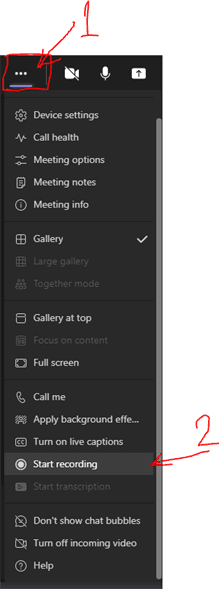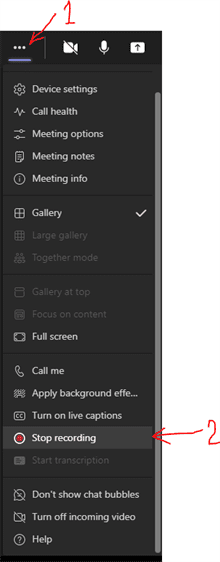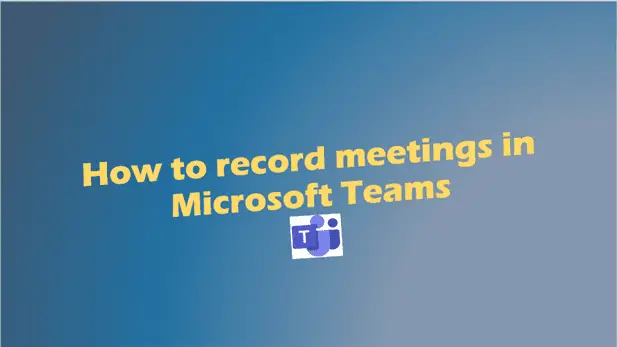How to record meeting in Microsoft Teams
How to record meeting in Microsoft Teams and where are Microsoft Teams recordings stored? This article covers these questions, plus more, all associated with Teams meeting recordings.
How to record Microsoft Teams meeting in desktop
Any Teams meeting or call can be recorded for viewing at a later time. The recording captures audio, video, and screen sharing activity. These recordings can be shared securely across your organization.
A recording will expire and be automatically deleted after a set period of time. The length of time it’s available is set by your IT admin, but you can change the expiration date of any given recording. For more info, see Manage the expiration of a meeting recording.
Who can record a Teams meeting?
Someone who wants to record Teams meeting OR record Teams call must meet the following criteria:
- Has one of the following licenses: Office 365 Enterprise E1, E3, E5, F3, A1, A3, A5, M365 Business, Business Premium, or Business Essentials.
- Has recording enabled by an IT admin.
- Isn’t a guest or from another organization.
Anyone who meets the above conditions can start or stop a recording, even if the meeting organizer isn’t present.
If you don’t meet the above conditions, you may see that the record Teams meeting greyed out.
| Type of user | Can start recording? | Can stop recording? |
|---|---|---|
| Meeting organizer | Yes | Yes |
| Person from same org | Yes | Yes |
| Person from another org or company | No | No |
| Guest | No | No |
| Anonymous | No | No |
Notes:
- Recording continues even if the person who started the recording has left the meeting.
- The recording stops automatically once everyone leaves the meeting. If someone forgets to leave, the recording automatically ends after four hours.
- If one of the participants has a policy for compliance recording, the meeting will be recorded according to the policy even if that participant is from another organization. (See: Are Microsoft Teams calls recorded automatically)
Start recording
When you start recording a meeting, you also turn on live transcriptions (if your IT admin allows transcriptions).
- Start or join the meeting.
- Go to the meeting controls and select:
- More actions
Start recording.


Everyone in the meeting gets notified that recording and transcription have started.
Notes:
- You can’t make multiple recordings of the same meeting at the same time. If one person starts recording a meeting, that recording will be stored on the cloud and available to all participants.
- Meeting participants have the option of viewing the transcription during the meeting.
Stop recording
- Go to the meeting controls and select
- More actions
- Choose one of the following:
- Stop recording: Stops the recording and live transcription.
- Stop transcription: Stops just the live transcription. The recording continues until you select Stop recording.
Where are Microsoft Teams recordings stored?
It’s useful to be aware that one-hour of recording takes up 400MB of storage space.
Microsoft Teams meeting recordings are no longer saved to Microsoft Stream, as of August 2021, All recordings are now saved to OneDrive and SharePoint.
Find Your recordings
For Recordings Stored in OneDrive or SharePoint
Recordings are available in different places depending on the type of meeting.
- The recording is processed and saved to:
- SharePoint if it was a channel meeting or
- OneDrive if it was any other type of meeting.
- The meeting recording shows up in the meeting chat or channel conversation (if you’re meeting in a channel).
Note: For now, guests and external attendees can view the recording only if it’s explicitly shared with them.
For Recordings Stored in Microsoft Stream
If your organization still uses Microsoft Stream, please note:
- After the recording has stopped, it’s processed (which could take a while) and saved to Microsoft Stream, and then it’s ready to play.
- The person who started the recording receives an email from Microsoft Stream when the recording is available. It also shows up in the meeting chat—or in the channel conversation if you’re meeting in a channel.
- If your IT admin has set a company policy for saving recordings to Microsoft Stream, you need to accept it before starting the recording.
Manage the expiration of a meeting recording
Your IT admin’s settings determine whether (and when) a recording will expire. If your recording has an expiration date, you’ll see a message indicating that when the recording pops into the meeting chat after the meeting ends.
Open the details pane to view or change the expiration date.
Privacy – How to record meeting in Microsoft Teams
Can you record Teams meetings secretly? When a meeting recording starts, Teams shows a notification to all participants on the Teams desktop, web, and mobile apps, as well as to people who joined via phone.
In some places, you legally need to get everyone’s permission before you can record them. Make sure you know the rules before you start.
Troubleshoot – How to record meeting in Microsoft Teams
If you’re having problems recording a meeting, you’ll probably need the help of your IT admin to work through them. Keep these things in mind as you move forward:
- Both the meeting organizer and recorder must have one of the following licenses: Office 365 Enterprise E1, E3, E5, F3, A1, A3, A5, M365 Business, Business Premium, or Business Essentials.
- An IT admin must provide a recording license to both the meeting organizer and the recorder.
- Guests or federated users can’t record meetings or calls.
Related Posts:
- What can my employer see on Microsoft Teams?
- How to Delete Chats in Microsoft Teams: Easy Steps to Follow






